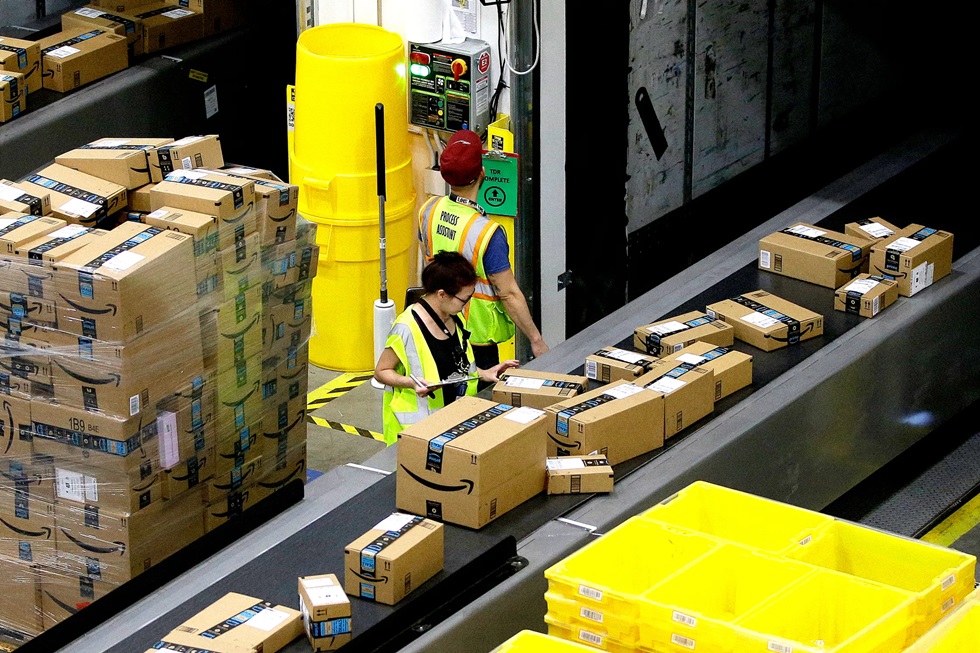
WASHINGTON—Ergonomic injuries to workers are proliferating in the nation’s warehouses, with an injury rate above national averages for all workplaces, a new report by the non-partisan Government Accountability Office says.
To solve that problem, GAO issued a range of recommendations for the Occupational Safety and Health Administration (OSHA) action against ergonomic injuries.
But, thanks to a law Republicans enacted when they first took complete congressional control 29 years ago, the recommendations are likely to go nowhere. And the report doesn’t name the prime source of warehouse ergonomic injuries, according to OSHA’s own data: Amazon.
“The transportation and warehousing sector, which includes e-commerce warehouses and last-mile delivery, had the highest serious injury and illness rate of all 19 sectors in 2022, with an estimated 3.8 cases per 100 workers, according to BLS data,” the last available to GAO, the report says.
“Overexertion and bodily reaction, the most common hazard, can cause musculoskeletal (ergonomic) disorders, such as tendonitis or back pain.”
What GAO does not say is Amazon skews all the OSHA warehouse job injury numbers, including the ergonomic numbers.
Its warehouse injury rate is 6.6 injuries per 100 workers, and it accounts for more than half of all ergonomic injuries, though it employs one-third of all warehouse workers.
The one-phrase explanation of why Amazon doesn’t fix conditions at its warehouses, which in turn drives up the injury numbers GAO cites, is “unacceptable corporate greed,” says Senate Labor Committee Chairman Bernie Sanders, Ind-Vt.
A big issue
Safety and health on Amazon warehouse floors was a big issue in the then-independent Amazon Labor Union’s campaign to unionize the monster firm’s warehouse just south of Albany, N.Y. Its election there failed due to rampant company labor law-breaking, says ALU, now an independent Teamsters local.
GAO recommends several OSHA actions to combat the ergonomic ills. They include “updated guidance” for OSHA inspectors “to use when identifying and assessing overexertion hazards,” more training in identifying the hazards, and a separate ergonomic hazard column in OSHA reports.
It also recommends offering ergonomic hazard training online and making the guidance and the training publicly available. And the OSHA inspections of warehouses for ergonomic hazards can’t just be, in plain English, one-and-done.
“The Secretary of Labor should ensure” OSHA “conducts timely follow-up with establishments that were issued an ergonomic hazard alert letter, as required by OSHA policy, to determine if establishments have taken corrective actions. This may include regional offices developing formal procedures for tracking ergonomic hazard alert letters,” GAO recommends.
The GAO report to Rep. Bobby Scott, D-Va., confirms the overall ergonomic danger to warehouse workers. But Senate Labor Committee Chairman Sanders singled out Amazon as the prime cause, more than a year ago.
“Amazon’s warehouses are uniquely dangerous,” Sanders wrote to company CEO Andre Jassy early in 2023, announcing an investigation into Amazon’s protection of its workers, or lack of it.
Citing the data GAO later used for its report, but splitting Amazon out, Sanders said “In 2022 alone, Amazon warehouse workers suffered nearly 39,000 injuries, 95% of which were so serious they required workers to either lose time at work or switch to modified duty. Amazon’s rate of serious injuries at its warehouses, at 6.6 injuries per 100 workers, was more than double the rate at non-Amazon warehouses.
“And despite constituting only a little more than a third of the warehouse workers in the country, Amazon workers suffered more serious injuries than all of the other warehouse workers in the United States combined.”
Sanders also pointed out Amazon has more than enough money to fix the ergonomics and other health and safety hazards in its warehouses. It reported grossing $30.4 billion worldwide last year.
“If Amazon can afford to spend $6 billion on stock buybacks last year, it can afford to make sure its warehouses are safe places to work. If Amazon can afford to pay you [Jassy] $289 million in total compensation over the past two years, it can afford to treat all of its workers with dignity and respect, not contempt,” Sanders wrote.
Rep. Scott, the top Democrat on the Republican-run and highly polarized House Education and the Workforce Committee, hailed the GAO report and promised legislation about ergonomics should Democrats retake House control in the November election.
Getting seriously hurt
“Workers who keep the American economy moving–the people who work in general warehousing and last-mile delivery–are getting seriously hurt on the job at rates that outpace most other industries. These are the kinds of serious injuries that can leave workers disabled and in chronic pain,” Scott said when releasing the GAO study of ergonomic injuries.
“The report details the consequences of weak worker protections and years of undercutting OSHA’s ability to do its job and protect workers from preventable hazards. Inadequate protections are not just bad for workers. When workers are hurt on the job, it is bad for business and the economy. Congress must pass the Let’s Protect Workers Act (HR9137) which will responsibly raise civil monetary penalties to deter unscrupulous employers from violating workers’ rights and ensure workers can return home safely at the end of a shift.”
Thomas Costa, director of the GAO division that wrote the report for Scott, explained its recommendations in an e-mail: “Congress repealed OSHA’s ergonomic standard that applied to all workers 20 some years ago. Our recs don’t call for new ergonomic standards but do call for clarified guidance and an evaluation of OSHA’s existing efforts regarding a more narrow group of workers with a distinctly higher rate of ergonomic work-related injuries.”
But Scott can’t write legislation to order OSHA to crack down on ergonomics violators, in warehouses or anywhere else, unless Congress repeals a Gingrich-era anti-ergonomics regulation law, first.
The Congressional Review Act blocks direct federal action forever on any rule Congress vetoes when the president signs that veto. The very first use of that law banned OSHA action forever to reduce ergonomic/musculoskeletal disorder injuries. So Scott’s solution is to hit the OSHA lawbreakers and rule-breakers—on ergonomics or anything else–where it hurts: In the wallet.
He used the report to push a Democratic measure, introduced earlier this year, vastly increasing fines against firms that break OSHA rules, wage and hour rules, and break the National Labor Relations Act, among other laws.
That measure, HR9137, has 33 co-sponsors, all Democrats. It would increase the current $5,000 minimum OSHA fine for one instance of breaking job safety rules to $60,000. The maximum fine, applied to firms with repeated willful and serious violations of OSHA rules, would rise from its current $70,000 to $800,000.
That legislation is going nowhere, too. Since Congress passed the anti-regulation law, the right-wing GOP-named majority on the U.S. Supreme Court gave a big green light to stopping all regulations in their tracks. In a key case last term, it overturned the presumption that regulatory agencies, such as OSHA, have the expertise to decide issues, such as ergonomics. Now every single rule will be subject to second-guessing by Congress or the courts.
In addition, OSHA Deputy Administrator James Frederick told GAO there’s no need for an industry-specific standard covering ergonomic injuries in warehouse work. He contends the agency’s “general duty clause” which mandates firms have a “general duty” to follow safety and health rules, and its general guidance on ergonomics, combine to cover the warehouse injuries problem.
“OSHA has prioritized industry-specific ergonomic guidance for industries where there are unique hazards,” such as hospitals and nursing homes, Frederick wrote in reply to the report’s findings.
Among those are hospitals and nursing homes, where lifting and turning patients produces large amounts of injuries, Frederick said. National Nurses United has long lobbied for a specific OSHA standard, not just “guidance” on that ergonomic hazard.
“But OSHA believes its more general ergonomic guidance adequately addresses ergonomic hazards encountered by employees in warehousing and delivery services,” said Frederick.
We hope you appreciated this article. At People’s World, we believe news and information should be free and accessible to all, but we need your help. Our journalism is free of corporate influence and paywalls because we are totally reader-supported. Only you, our readers and supporters, make this possible. If you enjoy reading People’s World and the stories we bring you, please support our work by donating or becoming a monthly sustainer today. Thank you!










